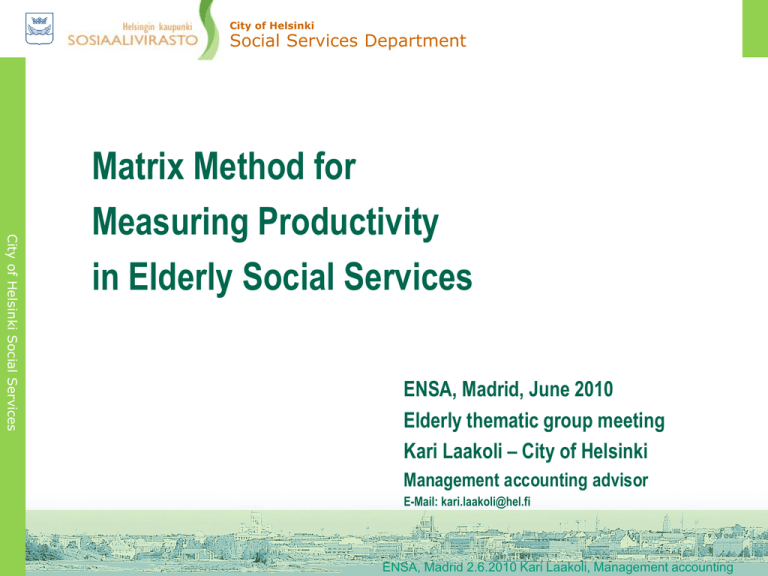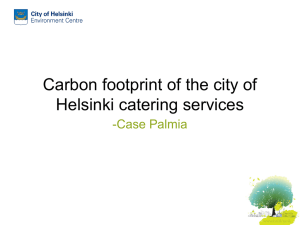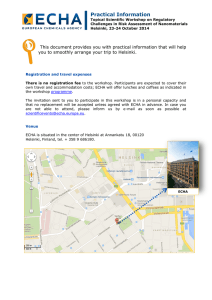Matrix Method for Measuring Productivity in Elderly
advertisement

City of Helsinki Social Services Department City of Helsinki Social Services Matrix Method for Measuring Productivity in Elderly Social Services ENSA, Madrid, June 2010 Elderly thematic group meeting Kari Laakoli – City of Helsinki Management accounting advisor E-Mail: kari.laakoli@hel.fi ENSA, Madrid 2.6.2010 Kari Laakoli, Management accounting City of Helsinki Social Services Department Outline of the presentation information of the elderly projects from aggregate to disaggregate approach City of Helsinki Social Services matrix method map of productivity affecting factors prioritized measures matrix of service housing productivity results in service housing in years 2007 - 2009 conclusion ENSA, Madrid 2.6.2010 Kari Laakoli, Management accounting City of Helsinki Social Services Department Information of the elderly projects pilot projects in the elderly services in years 2007 - 2009 13 units of service housing four nursing homes City of Helsinki Social Services aim was to develop a solution to a productivity measurement problem from a practical field utilization of workshops as a method two different working teams included two researcher from Tampere University of Technology 3-5 persons of elderly services (unit manager, workers representatives, accounting experts) followed generic process of designing performance measures ENSA, Madrid June 2010 Kari Laakoli, Management accounting City of Helsinki Social Services Department The matrix method From aggregate to disaggregate approach Top down City of Helsinki Social Services Aggregate measures are intended to examine productivity of a large organizational entity or the whole organization Bottom up Component measures (disaggregate) capture the productivity of a single activity or unit Social Services Department is rather large organizational entity productivity measurement was based on output/input index limited view when information to the unit level is needed Reference: Jääskeläinen, A. 2009 ENSA, Madrid 2.6.2010 Kari Laakoli, Management accounting City of Helsinki Social Services Department The matrix method From aggregate to disaggregate approach Complexity of the system City of Helsinki Social Services Social Service System as a whole Part of the service system (eg. elderly services) Unit level (eg. Service housing) Weak view of system productivity Awareness Productivity of is productivity understood phenomenon and known Productivityconsciousness •Social Service System is a large organizational entity, state of productivity is difficult to realize and manage, offer little information to unit level • Productivity is realized, but the underlying factors needs to be better understood, measured and managed by objectives • At the unit level productivity and factors involved in the phenomenon should be understood, measured and managed by objectives ENSA, Madrid 2.6.2010 Kari Laakoli, Management accounting City of Helsinki Social Services Department The matrix method From aggregate to disaggregate approach Productivity of City of Helsinki Bottom-up City of Helsinki Social Services the results from different unit Productivity of Social Service Department … are aggregated to the next level focus is to examine a change Productivity of Productivity of Child care Services Elderly services … … in total score not the score as such Productivity of Productivity of Productivity of Child Care regions Nursing home 1 … … Service house 1 … every unit is taken into account by its weighted costs Productivity of Child Day care center 1 … Reference: Jääskeläinen, A. 2009 ENSA, Madrid 2.6.2010 Kari Laakoli, Management accounting City of Helsinki Social Services Department The matrix method Map of different factors affecting productivity Productivity City of Helsinki Social Services Bedfast residents % Functional loss of client % Service quality Atmosphere In Service provision Workers turnover Employee competence Working atmosphere Cost efficiency Utilization of employee resources Output quantity Output magnitude Resources used References: Jääskeläinen, A. 2009 Jääskeläinen, A. & Lönnqvist, A. 2009 ENSA, Madrid 2.6.2010 Kari Laakoli, Management accounting City of Helsinki Social Services Department The matrix method The illustration of the measures Weight value City of Helsinki Social Services Service Housing Measurement objective Measure Cost of calculated care day € 45% Productivity Employee resources Work contribution in a year per number of customer bed % 15% Utilization of premises Degree of utilization of premises % 15% Absences of emplyees Percentage of days lost through sickness % (under 60 days) 10% Function of client Functional loss % 15% Function of client Bedfast residents % 100% Nursing Home 45% 10% 10% 10% 15% 10% 100% Reference: Jääskeläinen, A. 2009 ENSA, Madrid 2.6. 2010 Kari Laakoli, Management accounting City of Helsinki Social Services Department The matrix method The illustration of the service housing matrix City of Helsinki Social Services Unit cost of calculated care € Measurement result 23,21 10 12 9 12,5 8 13 7 14 6 15 5 16 4 17 3 19 2 21 1 23 0 25 Score 0 Weight 45 Weighted score 0 Total score work input in year per number customer bed 0,36 0,28 0,29 0,3 0,31 0,34 0,37 0,4 0,5 0,6 0,7 0,8 5 15 75 degree of utilization of premises 94 100 99,9 99,7 99,5 99 97 95 92,5 90 85 80 3 15 45 rate of short sickness absences % 3,79 3 3,2 3,4 3,7 4 4,5 5 6 7 8 10 6 10 60 percentage of customer with deteriorating condition 11,8 10 14 18 22 26 30 34 40 47 55 65 9 15 135 315 Reference: Jääskeläinen, A. 2009 ENSA, Madrid 2.6.2010 Kari Laakoli, Management accounting City of Helsinki Social Services Department The matrix method Productivity measurements in service housing 2008 13 12 11 10 9 8 7 6 5 4 3 2 2009 1 City of Helsinki Social Services 1000 900 800 700 600 500 400 300 200 100 0 top level 900 - 1000 pontis extraordinary level 700 - 800 points good level 500 – 600 points average level 400 points ENSA, Madrid 2.6.2010 Kari Laakoli, Management accounting City of Helsinki Social Services Department The matrix method Productivity index in service housing index 09/08 13 12 11 10 9 8 7 6 5 4 3 2 index 09/08 1 City of Helsinki Social Services level describing productivity development =100 200 175 150 125 100 75 50 25 0 ENSA, Madrid 2.6.2010 Kari Laakoli, Management accounting City of Helsinki Social Services Department Conclusion The matrix method provides: tool for managerial purposes City of Helsinki Social Services one index calculated from several productivity-related indicators easy to understand what factors have influenced the index the matrix is not very complex: the measurement method is transparent to every employee shows what a good result is benchmarking to other units using similar matrix potential tool for supporting payment by results Reference: Jääskeläinen, A. 2009 ENSA, Madrid 2.6.2010 Kari Laakoli, Management accounting City of Helsinki Social Services Department City of Helsinki Social Services Thank you for your attention and interest. ENSA, Madrid 2.6.2010 Kari Laakoli, Management accounting City of Helsinki Social Services Department References: Jääskeläinen A. 2009. ”Identifying a Suitable Approach for Measuring and Managing Public Service Productivity”, Electronic Journal of Knowledge Management, Vol 7, No. 4 pp. 447-458. Jääskeläinen, A. & Lönnqvist, A. 2009. ”Designing Operative Productivity Measures in Public Services”, VINE – Journal of Information and Knowledge Management Systems, Vol. 39, No. 1, pp. 55-67. www.interrai.org City of Helsinki Social Services ENSA, Madrid 2.6.2010 Kari Laakoli, Management accounting City of Helsinki Social Services Department Productivity in the elderly services Converting values Current costs (nominal) were converted to real costs (constant) by City of Helsinki Social Services the PIPE index (Price index of public expenditure) PIPE Producer: Statistics Finland, Homepage: http://tilastokeskus.fi/til/jmhi/index_en.html Weighting of the output Service housing Client payment grouping (grouping is based on given service hours per month) Groups 1-6 where one elderly client in group six equate six elderly client in group one Nursing homes RUG-III/34 grouping (hierarchical structure) Cost weigh of client structure (based on clinical status) average client has weight 1; weight 1,3 means that client need 30% more resources Reference: Jääskeläinen, A. 2009 ENSA, Madrid 2.6.2010 Kari Laakoli, Management accounting City of Helsinki Social Services Department The matrix method Constructing a productivity matrix prioritize the measures the experience and context specific knowledge important City of Helsinki Social Services statistical study to support the decision of the weights to finalize matrix collect a measurement data from each measure (previous 3 years) scaling the matrix 0 – 10 average result got a score of 4 Scores 0 and 10 defined in a way that only single units had such scores current values of measurements was necessary information Reference: Jääskeläinen, A. 2009 ENSA, Madrid 2.6.2010 Kari Laakoli, Management accounting






